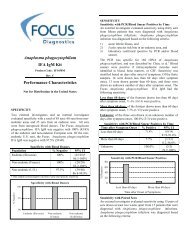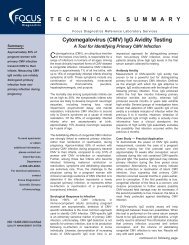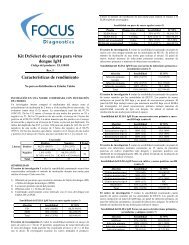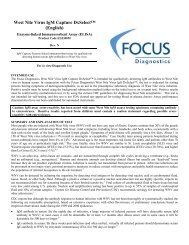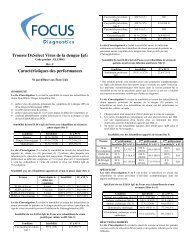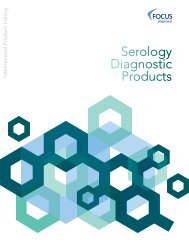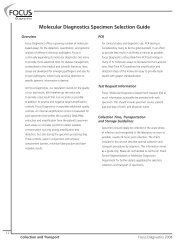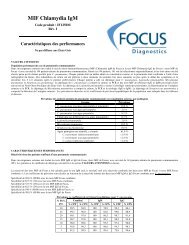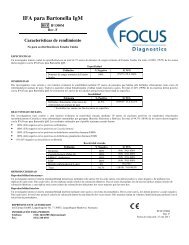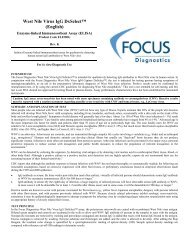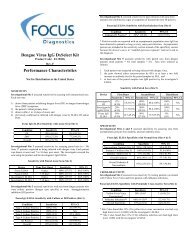HerpeSelect® 2 ELISA IgG test is intended for - Focus Diagnostics
HerpeSelect® 2 ELISA IgG test is intended for - Focus Diagnostics
HerpeSelect® 2 ELISA IgG test is intended for - Focus Diagnostics
- No tags were found...
Create successful ePaper yourself
Turn your PDF publications into a flip-book with our unique Google optimized e-Paper software.
HerpeSelect ® 2 <strong>ELISA</strong> <strong>IgG</strong>(Engl<strong>is</strong>h)REF EL0920GRev. KEnzyme-linked immunosorbent assay (<strong>ELISA</strong>) <strong>for</strong> thequalitative detection of human <strong>IgG</strong> class antibodies toHSV-2For in vitro Diagnostic UseINTENDED USE<strong>Focus</strong> <strong>Diagnostics</strong>’ HerpeSelect ® 2 <strong>ELISA</strong> <strong>IgG</strong> <strong>test</strong> <strong>is</strong> <strong>intended</strong> <strong>for</strong> qualitatively detecting the presence or absence of human <strong>IgG</strong> class antibodies to HSV-2 inhuman sera. In conjunction with the <strong>Focus</strong> <strong>Diagnostics</strong> HerpeSelect ® 1 <strong>ELISA</strong> <strong>IgG</strong>, the <strong>test</strong> <strong>is</strong> indicated <strong>for</strong> <strong>test</strong>ing sexually active adults or expectant mothers <strong>for</strong>aiding in the presumptive diagnos<strong>is</strong> of HSV infection. The predictive value of a positive or negative result depends on the population’s prevalence and the pre<strong>test</strong>likelihood of HSV-2 infection. The assay can be used manually or in conjunction with an automated system as outlined in the package insert. The user <strong>is</strong>responsible <strong>for</strong> assay per<strong>for</strong>mance character<strong>is</strong>tics when an automated system <strong>is</strong> used. The per<strong>for</strong>mance of th<strong>is</strong> assay has not been establ<strong>is</strong>hed <strong>for</strong> use in a pediatricpopulation, <strong>for</strong> neonatal screening, or <strong>for</strong> <strong>test</strong>ing of immunocomprom<strong>is</strong>ed patients.SUMMARY AND EXPLANATION OF TESTHSV <strong>is</strong> a common human pathogen found worldwide which produces a wide variety of d<strong>is</strong>eases. HSV infects neonates, children and adults, and, by the fourthdecade, more than 90% of the adult population demonstrate antibodies to HSV. 1 HSV transm<strong>is</strong>sion can result from direct contact with infected secretions fromeither a symptomatic or an asymptomatic host.Herpes Simplex virus has been characterized into 2 d<strong>is</strong>tinct serotypes: HSV-1 and HSV-2. HSV-1 <strong>is</strong> generally associated with infection in the tongue, mouth,lips, pharynx and eyes, whereas HSV-2 <strong>is</strong> primarily associated with genital and neonate infection.In the U.S., most young sexually active persons with genital ulcers have genital herpes. 2 Genital ulcers have been associated with an increased r<strong>is</strong>k <strong>for</strong> HIVinfection. 2 Genital herpes <strong>is</strong> usually caused by HSV-2, with the minority of first genital ep<strong>is</strong>odes (5-30%) caused by HSV-1. 2 Many cases of genital herpes aretransmitted by persons who are unaware that they are infected or do not recognize subtle or atypical symptoms. The Centers <strong>for</strong> D<strong>is</strong>ease Control and Prevention(CDC) states that counseling <strong>is</strong> an important aspect of managing patients who have genital herpes. 2One of the most serious consequences of genital herpes <strong>is</strong> neonatal herpes. 3 Without therapy, mortality <strong>for</strong> untreated infants who develop d<strong>is</strong>seminated infectionexceeds 70% 3,4 with half of the survivors developing neurological impairment. 4 Almost all neonate HSV-2 infections are acquired by passage through an infectedbirth canal. 2 Most mothers (70%) who transmit HSV to their children are asymptomatic at delivery. 5 Transm<strong>is</strong>sion rates are much higher when the mother <strong>is</strong>experiencing a primary or initial genital infection (> 50%) 6 versus a recurrent infection (< 5%), 7-10 and where the mother <strong>is</strong> not yet producing <strong>IgG</strong> antibodies toHSV. 8 CDC recommends that “...prevention of neonatal herpes should emphasize the prevention of acqu<strong>is</strong>ition of genital HSV infection during late pregnancy.Susceptible women whose partners have oral or genital HSV infection, or those whose sex partners’ infection status <strong>is</strong> unknown, should be counseled to avoidunprotected genital and oral sexual contact during late pregnancy”. 2 Mothers are at greater r<strong>is</strong>k <strong>for</strong> contracting a primary or initial genital HSV infection whenthey are seronegative to one or both HSV types, and their partner <strong>is</strong> seropositive. 8Primary HSV-1 infections, acquired through direct person-to-person (primarily nongenital) contact, usually occur in the first decade. 4 When the primary HSV-1infection <strong>is</strong> clinical, the classic presentation <strong>is</strong> herpes gingivostomatit<strong>is</strong>, a serious infection of the gums, mouth, tongue, lip, face and/ or pharynx. Due to virusreactivation, recurrent HSV-1 infection in the <strong>for</strong>m of herpes labial<strong>is</strong> (fever bl<strong>is</strong>ters or cold sores) or ocular herpes occurs in up to 40% of the HSV-1 seropositivegroup. 11 A previous oral HSV-1 infection does not protect against a genital HSV-2 infection. 11Primary HSV-2 infections, usually acquired through sexual contact, are rarely found be<strong>for</strong>e the onset of sexual activity. When the primary HSV-2 infection <strong>is</strong>clinical, the classic presentation <strong>is</strong> herpes genital<strong>is</strong>, an infection characterized by bilaterally d<strong>is</strong>tributed lesions in the genital area accompanied by fever, inguinallymphadenopathy and dysuria. HSV-2 infections cause approximately 85% of symptomatic primary genital HSV cases, with HSV-1 infections causing theremainder. 3 Since HSV-1 <strong>is</strong> unlikely to produce recurrent genital infections, 99% of recurrent genital herpes <strong>is</strong> due to HSV-2 infection. 3After primary HSV infection, the virus colonizes the sensory neurons, and the latent infection may reactivate causing recurrent sub-clinical or clinical infection.Since recurrent infections may be sub-clinical, and asymptomatic virus shedding <strong>is</strong> a significant reservoir <strong>for</strong> virus transm<strong>is</strong>sion, 1 unexpected virus transm<strong>is</strong>sionoccurs and <strong>is</strong> difficult to prevent. 3Viral <strong>is</strong>olation, direct fluorescent antibody (DFA) <strong>test</strong>ing, and serology can be used to diagnose HSV infections. Positive culture and DFA are the most definitiveand viral <strong>is</strong>olation allows typing of the viral <strong>is</strong>olate. However, length of culture time, specimen collection and transport difficulties, procedural complexity, andother variables are associated with DFA and culture. 1,2 Most ex<strong>is</strong>ting serologic methods <strong>for</strong> assessing HSV sero-status use viral lysate as antigens. However, dueto significant cross-reactivity between HSV-1 and HSV-2, the viral lysate assays are unable to differentiate HSV1 infections from HSV-2 infections. 3 Since mostadults have had prior HSV-1 infection, often without primary or recurrent symptoms, HSV-2 serostatus <strong>is</strong> often impossible to determine with confidence using aviral lysate assay. 3 Recently, HSV type-specific serological assays have been developed using the significant difference between the gG-1 protein of HSV-1 andthe gG-2 of HSV-2. 3 The <strong>Focus</strong> <strong>Diagnostics</strong> <strong>ELISA</strong> uses purified recombinant type-specific gG-2 antigen immobilized on polystyrene microwells.TEST PRINCIPLEIn the <strong>Focus</strong> <strong>Diagnostics</strong> HerpeSelect ® 2 <strong>ELISA</strong> <strong>IgG</strong> assay, the polystyrene microwells are coated with recombinant gG-2 antigen. Diluted serum samples andcontrols are incubated in the wells to allow specific antibody present in the samples to react with the antigen. Nonspecific reactants are removed by washing, andperoxidase-conjugated anti-human <strong>IgG</strong> <strong>is</strong> added and reacts with specific <strong>IgG</strong>. Excess conjugate <strong>is</strong> removed by washing. Enzyme substrate and chromogen areadded, and the color <strong>is</strong> allowed to develop. After adding the Stop Reagent, the resultant color change <strong>is</strong> quantified by a spectrophotometric reading of opticaldensity (OD). Sample optical density readings are compared with reference cut-off OD readings to determine results.MATERIALS SUPPLIEDThe <strong>Focus</strong> <strong>Diagnostics</strong> HerpeSelect ® 2 <strong>ELISA</strong> <strong>IgG</strong> Test kit contains sufficient materials to per<strong>for</strong>m 96 determinations. Allow the supplied reagents to warm toroom temperature be<strong>for</strong>e use. All un-opened materials are stable at 2 to 8°C until the expiration date stated on the reagent label.
HerpeSelect ® 2 <strong>ELISA</strong> <strong>IgG</strong>Page 38. Bacterial contamination of serum specimens or reagents can produce erroneous results. Use aseptic techniques to avoid microbial contamination.9. Per<strong>for</strong>m the assay at room temperature (approximate range 20 to 25°C).10. Use proper pipetting techniques, maintaining the pipetting pattern throughout the procedure to ensure optimal and reproducible values.11. The stop reagent contains sulfuric acid. Do not allow to contact skin or eyes. If exposed, flush with copious amounts of water.SPECIMEN COLLECTION AND PREPARATIONSerum <strong>is</strong> the specimen source. No attempt has been made to assess the assay’s compatibility with other specimens. Hyperlipemic, heat-inactivated, hemolyzed, orcontaminated sera may cause erroneous results; there<strong>for</strong>e, their use should be avoided.Specimen Collection and HandlingCollect blood samples aseptically using approved venipuncture techniques by qualified personnel. 12 Allow blood samples to clot at room temperature prior tocentrifugation. Aseptically transfer serum to a tightly closing sterile container <strong>for</strong> storage. Separated serum should remain at 22°C <strong>for</strong> no longer than 8 hours. Ifthe assay will not be completed within 8 hours, refrigerate the sample at 2 to 8°C. If the assay will not be completed within 48 hours, or <strong>for</strong> shipment of samples,freeze at –20°C or colder. Thaw and mix samples well prior to use.Specimen, Controls and Calibrator PreparationDilute each specimen, control and calibrator 1:101. For example, label tubes and d<strong>is</strong>pense 1000 µL of Sample Diluent into each labeled tube. Add 10 µL ofspecimen, control or calibrator to each appropriate tube containing the 1000 µL Sample Diluent and mix well by vortex mixing.TEST PROCEDURE1. Bring all reagents to room temperature be<strong>for</strong>e use. Remove the Antigen Well packet from cold storage. To avoid condensation, allow micro-well strips toreach room temperature be<strong>for</strong>e opening the foil packet. If less than a full plate <strong>is</strong> to be used, return unused strips to the foil packet with desiccant and resealcompletely. Store unused antigen wells at 2 to 8°C. (Note: At the end of the assay, retain the frame <strong>for</strong> use with the remaining strips.)2. OPTIONAL 5 minute Pre-Soak. If omitting pre-soak, proceed to Step 3.Fill wells with 1X Wash Buffer and soak <strong>for</strong> 5 minutes. Decant (or aspirate) the Antigen Wells and tap vigorously to remove 1X Wash Buffer. Blot theemptied Antigen Wells face down on clean paper towels or absorbent paper to remove residual 1X Wash Buffer.3. D<strong>is</strong>pense 100 µL of the Sample Diluent into the “blank” well and 100 µL of each diluted specimen, control or calibrator (see Specimen, Controls, andCalibrator Preparation, above) into the appropriate wells. (Note: For runs with more than 48 wells it <strong>is</strong> recommended that 250 µL of each diluted samplefirst be added to a blank microtiter plate in the location corresponding to that in the <strong>ELISA</strong> wells. The samples can then be efficiently transferred into theAntigen Wells with a 100 µL 8 or 12-channel pipettor.)4. Cover plates with sealing tape (or place in a humid chamber), and incubate <strong>for</strong> 60 ± 1 minute at room temperature (20 to 25°C).5. Remove sealing tape (or remove wells from the humid chamber), and empty the contents of the wells into a sink or a d<strong>is</strong>card basin.6. Fill each well with a gentle stream of 1X Wash Buffer solution from a wash bottle then empty contents into a sink or a d<strong>is</strong>card basin.7. Repeat wash (step 6) an additional 2 times.8. Tap the antigen wells vigorously to remove 1X Wash Buffer. Blot the emptied Antigen Wells face down on clean paper towels or absorbent paper toremove residual 1X Wash Buffer.9. D<strong>is</strong>pense 100 µL Conjugate to all wells, using a 100 µL 8 or 12-channel pipettor.10. Cover plates with sealing tape (or place in a humid chamber) and incubate <strong>for</strong> 30 ± 1 minutes at room temperature (20 to 25°C).11. Repeat wash steps 5 through 8.12. Pipet 100 µL of Substrate Reagent to all wells, using a 100 µL 8 or 12-channel pipettor. Begin incubation timing with the addition of Substrate Reagent tothe first well. (Note: Never pour the substrate reagent into the same trough as was used <strong>for</strong> the conjugate.)13. Incubate <strong>for</strong> 10 ± 1 minutes at room temperature (20 to 25°C).14. Stop the reaction by adding 100 µL of Stop Reagent to all wells using a 100 µL 8 or 12-channel pipettor. Add the Stop Reagent in the same sequence and atthe same pace as the Substrate was added. In antibody-positive wells, color should change from blue to yellow.15. Gently blot the outside bottom of wells with a paper towel to remove droplets that may interfere with reading by the spectrophotometer. Do not rub with thepaper towel as it may scratch the optical surface of the well. (Note: Large bubbles on the surface of the liquid may affect the OD readings.)16. Measure the absorbance of each well within 1 hour of stopping the assay. Set the microwell spectrophotometer at a wavelength of 450 nm. Zero theinstrument on the blank wells, or correct all ODs by manually subtracting the blank ODs.QUALITY CONTROLEach plate run (or strips or wells from a single plate) must include the Cut-off Calibrator and all 3 controls. If multiple plates are run, include the Cut-offCalibrator and all 3 controls on each plate. It <strong>is</strong> recommended that until the user becomes familiar with the kit per<strong>for</strong>mance, all specimens, controls and the CutoffCalibrator should be run in duplicate with the Cut-off Calibrator run twice <strong>for</strong> a total of 4 wells. If single wells are used, the Cut-off Calibrator should be runin triplicate. Include a minimum of 1 blank well (containing sample diluent only) <strong>for</strong> instrument calibration purposes.The Cut-off Calibrator has been <strong>for</strong>mulated to give the optimum differentiation between negative and positive sera. Although the absorbance value may varybetween runs and between laboratories, the mean value <strong>for</strong> the Cut-off Calibrator wells must be within 0.100 to 0.700 OD units. All replicate Cut-off CalibratorODs should be within 0.10 absorbance units from the mean value.Report results as index values relative to the Cut-off Calibrator. To calculate index values, divide specimen optical density (OD) values by the mean of the CutoffCalibrator absorbance values.1. The High Positive Control index value should be greater than 3.5.2. The Low Positive Control index value should be between 1.5 and 3.5.3. The Negative Control index value should be less than 0.8.If the Calibrator or controls are not within these parameters, patient <strong>test</strong> results should be considered invalid and the assay repeated.The Positive and Negative Controls are <strong>intended</strong> to monitor <strong>for</strong> substantial reagent failure. The Positive Control should not be used as an indicator <strong>for</strong> cutoffprec<strong>is</strong>ion and only ensures reagent functionality. The Cut-off Calibrator and controls may be <strong>for</strong>mulated using the same lots of raw materials. Additional controlsmay be <strong>test</strong>ed according to guidelines or requirements of local, state, and/or federal regulations or accrediting organizations.
HerpeSelect ® 2 <strong>ELISA</strong> <strong>IgG</strong>Page 5Relative Sensitivity and Relative Specificity with Expectant Mothers†An outside investigator assessed the device’s relative sensitivity and relative specificity with sera from expectant mothers (n = 241). The sera were sequentiallysubmitted to the laboratory, archived, and masked. The reference method was a HSV-2 Western Blot (WB) from a Pacific Northwest university. Of 3 atypicalWBs, <strong>ELISA</strong> was 1 equivocal and 2 negatives. Of 58 WB positives, <strong>ELISA</strong> was 58 positives. Of 180 WB negatives, <strong>ELISA</strong> was 172 negatives, 7 positives, and 1equivocal.Relative Sensitivity and Relative Specificity with Expectant Mothers (n =241) †Character<strong>is</strong>tic % (EL/WB)* 95%CISensitivity relative to Western Blot 100% (58/58) 93.8-100%Specificity relative to Western Blot 96.1% (172/179) 92.1-98.4%* Excludes 3 atypical Western Blots and 1 <strong>ELISA</strong> equivocal.† The word “relative” refers to comparing th<strong>is</strong> assay’s results with those of a similar assay. No attempt was made to correlate the assay results to d<strong>is</strong>easepresence or absence. No judgment can be made on the similar assay’s accuracy in predicting d<strong>is</strong>ease.Relative Sensitivity and Relative Specificity with Sexually Active Adults†An outside investigator assessed the device’s relative sensitivity and relative specificity with sera from sexually active adults over the age of 14 (n = 246). Thesera were sequentially submitted to the laboratory, archived, and masked. The reference method was a HSV-2 Western Blot from a Pacific Northwest university.Of 5 atypical WBs, <strong>ELISA</strong> was 2 equivocals, 2 negatives and 1 positive. Of 76 WB positives, <strong>ELISA</strong> was 73 positives and 3 negatives. Of 165 WB negatives,<strong>ELISA</strong> was 159 negatives, 5 positives, and 1 equivocal.Relative Sensitivity and Relative Specificity with Sexually Active Adults (n=246) †Character<strong>is</strong>tic % (EL/WB)* 95%CISensitivity relative to Western Blot 96.1% (73/76) 88.9-99.2%Specificity relative to Western Blot 97.0% (159/164) 93.0-99.0%* Excludes 5 atypical Western Blots and 1 <strong>ELISA</strong> equivocal† The word “relative” refers to comparing th<strong>is</strong> assay’s results with those of a similar assay. No attempt was made to correlate the assay results to d<strong>is</strong>easepresence or absence. No judgment can be made on the similar assay’s accuracy in predicting d<strong>is</strong>ease.Relative Sensitivity with Culture Positives†An outside investigator assessed the device’s relative sensitivity using sera from culture positive patients (n = 63). Reference methods included culture (infection)and a HSV-2 Western Blot (antibody) from a Pacific Northwest university. Of 5 atypical WBs, <strong>ELISA</strong> was 2 equivocals, 2 negatives and 1 positive. Of 63culture positives, <strong>ELISA</strong> was 61 positives and 2 negatives, and WB was 62 positives and 1 negative. Of 62 WB positives, <strong>ELISA</strong> was 61 positives and 1negative.Relative Sensitivity with Culture Positives (n = 63) †Character<strong>is</strong>tic % (EL/WB or Culture) 95%CISensitivity relative to Culture 96.8% (61/63)* 89.0-99.6%Sensitivity relative to Western Blot 98.4% (61/62)* 91.3-100%* Of the 2 <strong>ELISA</strong> negatives, 1 was WB positive and the other WB negative.† The word “relative” refers to comparing th<strong>is</strong> assay’s results with those of a similar assay. No attempt was made to correlate the assay results to d<strong>is</strong>easepresence or absence. No judgment can be made on the similar assay’s accuracy in predicting d<strong>is</strong>ease.Agreement with CDC PanelThe following in<strong>for</strong>mation <strong>is</strong> from a serum panel obtained from the CDC and <strong>test</strong>ed by <strong>Focus</strong> <strong>Diagnostics</strong>. The results are presented as a means to convey furtherin<strong>for</strong>mation on the per<strong>for</strong>mance of th<strong>is</strong> assay with a masked, characterized serum panel. Th<strong>is</strong> does not imply an endorsement of the assay by the CDC. The panelcons<strong>is</strong>ts of 37% positive and 63% negative samples. The <strong>Focus</strong> <strong>Diagnostics</strong> HerpeSelect ® 2 <strong>ELISA</strong> <strong>IgG</strong> demonstrated 100% total agreement with the CDCresults. Of the results obtained by <strong>Focus</strong> <strong>Diagnostics</strong>, there was 100% agreement with the positive specimens and 100% agreement with the negative specimens.Relative Specificity with a Low Prevalence Population†An outside investigator assessed the device’s relative specificity using sera from a population of college students claiming to lack sexual experience (n = 81), andhaving a publ<strong>is</strong>hed HSV-2 antibody prevalence of 2% (4/186). 13 The laboratory reference method was a HSV-2 Western Blot from a Pacific Northwestuniversity. 1 atypical WB was an <strong>ELISA</strong> negative. Of 78 WB negatives, <strong>ELISA</strong> was 77 negatives and 1 positive. Of 2 WB positives, <strong>ELISA</strong> was 2 positives.Relative Specificity with a Low Prevalence Population (n = 81) †Character<strong>is</strong>tic % (EL/WB)* 95%CISpecificity relative to Western Blot 98.7% (77/78) 93.1-100%Sensitivity relative to Western Blot 100% (2/2) 15.8-100%* Excludes 1 atypical Western Blot.† The word “relative” refers to comparing th<strong>is</strong> assay’s results with those of a similar assay. No attempt was made to correlate the assay results to d<strong>is</strong>easepresence or absence. No judgment can be made on the similar assay’s accuracy in predicting d<strong>is</strong>ease.Type Specificity with HSV-1 Western Blot Positives†An outside investigator assessed the device’s type specificity using HSV-1 Western Blot positive and HSV-2 Western Blot negative sera from the abovedescribed populations (n = 287): expectant mothers, sexually active adults, low prevalence persons, and HSV-1 culture positives. Of 287 HSV-1 WB positive andHSV-2 WB negative samples, <strong>ELISA</strong> was 276 negatives, 1 equivocal and 10 positives.Type Specificity with HSV-1 Western Blot Positives (n = 287) †Character<strong>is</strong>tic % (EL/WB)* 95%CIType specificity relative to Western Blot 96.5% (276/286) 93.7-98.3%Type cross-reactivity relative to Western Blot 3.5% (10/286) 1.7-6.3%* Excludes 1 equivocal <strong>ELISA</strong> result.† The word “relative” refers to comparing th<strong>is</strong> assay’s results with those of a similar assay. No attempt was made to correlate the assay results to d<strong>is</strong>easepresence or absence. No judgment can be made on the similar assay’s accuracy in predicting d<strong>is</strong>ease.
HerpeSelect ® 2 <strong>ELISA</strong> <strong>IgG</strong>Page 6Cross-reactivity with Taxonomically Related Viruses<strong>Focus</strong> assessed the device’s cross-reactivity using sera (n = 27) from 1) HSV sero-negative by another manufacturer’s FDA cleared HSV <strong>ELISA</strong>s, and 2) IFA<strong>IgG</strong> positive <strong>for</strong> taxonomically similar viruses including CMV, EBV VCA, HHV6 and VZV. D<strong>is</strong>crepants between the FDA cleared HSV <strong>ELISA</strong>s and the <strong>Focus</strong>device were analyzed using a type specific Western Blot from a Pacific Northwest university.Cross-reactivity with Taxonomically Related Viruses (n = 27)IFA <strong>IgG</strong> Pos % Agreement Negative* 95%CICMV 91.7% (11/12) 61.5-99.8%EBV VCA 90.9% (20/22) 70.8-98.9%HHV6 90.9% (20/22) 70.8-98.9%VZV 90.5% (19/21) 69.6-98.8%Total 90.9% (70/77) 82.2-96.3%* Excludes 3 Western Blot positives, and 1 d<strong>is</strong>crepant that was not analyzed with the Western Blot because of insufficient volume.Intra-assay and Inter-assay ReproducibilityAn internal investigator assessed the device’s intra-assay and inter-assay reproducibility by assaying 7 samples in duplicate, twice a day, <strong>for</strong> 20 days, <strong>for</strong> a totalof 40 runs. 2 sets of samples were masked duplicates.Inter-lot ReproducibilityAn internal investigator assessed the device’s inter-lot reproducibility. 5 samples were run on 3 separate days with 3 separate lots. For 1 lot, the samples were runin triplicate, and run in duplicate with the other 2 lots. Each of the 3 lots had a different lot of Antigen Wells.Inter-laboratory ReproducibilityAn internal investigator and 2 off-site laboratories assessed the device’s inter-laboratory reproducibility. Each of the 3 laboratories ran 7 samples in triplicate on3 different days. 3 points were excluded because an incorrect sample (instead of sample 27) was run 1 day.ReproducibilityInter- & Intra-assay Inter-lot Inter-labSampleIntra-assay Inter-assay%CV of LabIndex MeanIndex Mean Index %CV Index Mean%CV %CVMeansLabMean of %CVs21* 0.18 20.5% 15.9% 0.28 52.4% 0.23 19.6% 17.3%26* 0.18 12.2% 12.4% NA NA 0.26 33.1% 20.7%22** 1.23 6.3% 6.2% 1.16 5.1% 1.19 3.9% 7.8%27** 1.22 5.2% 6.3% NA NA 1.14 14.1% 8.8%23 1.79 4.7% 5.5% 1.76 5.4% 1.73 5.2% 7.1%24 3.42 3.2% 7.9% 3.18 16.7% 2.77 11.0% 10.8%25 8.17 3.0% 6.9% 7.99 7.4% 6.82 18.6% 4.5%* #21 & #26 are same material.** #22 & #27 are same material.% Agreement between the Manual and Automated Methods (n = 257)An internal and an external investigator compared % agreement between the HerpeSelect automated method vs. the manual method as part of a CLIA validation<strong>for</strong> a major clinical laboratory located in Southern Cali<strong>for</strong>nia. The external investigator sequentially selected and manually <strong>test</strong>ed 257 samples. Each sample wasfrom an adult, and was submitted <strong>for</strong> HSV <strong>test</strong>ing. 255 samples were from the U.S., and 2 samples from outside the U.S. Of the 257 samples, the manual methoddetected 175 negatives, 3 equivocals, and 79 positives. Of the 175 negatives by the manual method, the automated method agreed with 99.4% (174/175). Of the 3equivocals by the manual method, the automated method agreed with 0% (0/3). Of the 79 positives by the manual method, the automated method agreed with98.7% (78/79). Overall, the 2 methods agreed 98.1% (252/257). Of the 5 d<strong>is</strong>crepants, 2 resolved in favor of the automated method, and the other 3 did notresolve.% Agreement between Manual and Automated MethodsInterpretation* % Agreement 95%CINegative 99.4% (174/175) 96.4-100%Equivocal 0.0% (0/3) 0.0-70.8%Positive 98.7% (78/79) 93.1-100%Overall 98.1% (252/257) 95.5-99.4%* Interpretation by manual method.Reproducibility Using an Automated InstrumentAn internal investigator assessed the device’s inter-assay and intra-assay reproducibility with an automated instrument. 10 samples were <strong>test</strong>ed in triplicate on 3different days. The manual and automated methods agreed 98.9% (89/90). 1 point from Sample 3 was an outlier (162 standard deviations from the mean).Stability after Opening ReagentsAn internal investigator assessed stability after the reagents had been opened and used with an automated instrument. The kit was used in the inter-assay/intraassayreproducibility study (above), re-closed, stored at 2 to 8°C <strong>for</strong> at least 30 days, and then used again to re-<strong>test</strong> the same samples. There was 100% agreementwith the index when the reagents were opened.REFERENCES1. Aurelian, L. Herpes Simplex Viruses. 473-497. In Specter, S & G Lancz (eds.). Clinical Virology Manual. 2 nd Ed. Elsevier, New York. (1992).2. Centers <strong>for</strong> D<strong>is</strong>ease Control and Prevention. Sexually transmitted d<strong>is</strong>eases treatment guidelines 2002. MMWR 2002:5 1 (No. RR-6).3. Arvin, A, C Prober. Herpes Simplex Viruses. 876-883. In Murray, P, E Baron, M Pfaller, F Tenover, and R Yolkenet (eds.). Manual of Clinical Microbiology. 6th Ed. ASM,Washington, D.C. (1995).4. Whitley, R. Herpes Simplex Viruses. 2297-223 1. In Fields, B, D Knipe, P Howley, et al. (eds.). Fields Virology 3 rd Ed. Lippincott-Raven, Philadelphia. (1996).5. Whitley, R, A Nahmias, A V<strong>is</strong>intine, C Fleming, C Al<strong>for</strong>d. Natural h<strong>is</strong>tory of herpes simplex virus infection of mother and newborn. Pediatrics 66:489-494 (1980).6. Whitley, R. Herpes simplex, in J Klein & J Remington (ed.), Infectious d<strong>is</strong>eases of the fetus and newborn infants, 3 rd ed., p.282-305.7. Prober, C, W Sullender, L Yasukawa, D Au, A Yaeger, A Arvin. Low r<strong>is</strong>k of herpes simplex virus infections in neonates exposed to the virus at the time of vaginal delivery tomothers with recurrent herpes simplex virus infections. N Engl J Med 3 16:240-244 (1987).8. Brown, Z, S Sleke, J Zeh, J Kopelman, A Maslow, R Ashley, D Watts, S Berry, M Herd, L Correy. The acqu<strong>is</strong>ition of herpes simplex virus during pregnancy. N Engl J Med337:509-515 (1997).9. Prober CG, Corey L, Brown ZA et al. 1992. The management of pregnancies complicated by genital infections with herpes simplex virus. Clin Infect D<strong>is</strong>. 15:1031-1038.
HerpeSelect ® 2 <strong>ELISA</strong> <strong>IgG</strong>Page 710. Brown ZA, Benedetti J, Ashley R et al. 1991. Neonatal herpes simplex virus infection in relation to asymptomatic maternal infection at the time of labor. N Engl J Med.324:1247-1252.11. Stewart, J. Herpes Simplex Virus. 554-559. In Rose, N, E deMacario, J Fahey, H Friedman, G Penn (eds.). Manual of Clinical Laboratory Immunology. 4 th Ed. ASM Press,Washington, D.C. (1992).12. NCCLS H18-A2. Procedures <strong>for</strong> the Handling and Processing of Blood Specimens; Approved Guideline. 2 nd Ed. (1999).13. Corey, L., A. Wald, New Developments in the Biology of Genital Herpes, in Clinical Management of Herpes Viruses, p.46.14. Ashley RL. Per<strong>for</strong>mance and use of HSV type-specific serology <strong>test</strong> kits. Herpes 2002 Jul;9(2):38-45.15. Ashley-Morrow R, Krantz E, Wald A. Time Course of Seroconversion by HerpeSelect <strong>ELISA</strong> After Acqu<strong>is</strong>ition of Genital Herpes Simplex Virus Type 1 (HSV-1) or HSV-2. SexTransm D<strong>is</strong>. 2003 Apr;30(4):3 10-314.16. Cherpes TL, Ashley RL, Meyn LA, Hillier SL. Longitudinal reliability of focus glycoprotein G-based type-specific enzyme immunoassays <strong>for</strong> detection of herpes simplex virustypes 1 and 2 in women. J Clin Microbiol 2003 Feb;41(2):671-4.17. Liljeqv<strong>is</strong>t et al. Typing of Clinical Herpes Simplex Virus Type 1 and Type 2 Isolates with Monoclonal Antibodies. J Clin Micro 37:2727-2718 (1999).18. CDC-NIH Manual. (1999) Biosafety in Microbiological and Biomedical Laboratories. 4 th ed. And National Committee <strong>for</strong> Clinical Laboratory Standards (NCCLS). Protection ofLaboratory Workers from Instruments, Biohazards and Infectious D<strong>is</strong>ease Transmitted by Blood, Body Fluids and T<strong>is</strong>sue (NCCLS M29-A).Th<strong>is</strong> package insert <strong>is</strong> available in French, German, Italian, and Span<strong>is</strong>h at www.focusdx.com, and may be available in other languages from your locald<strong>is</strong>tributor.AUTHORIZED REPRESENTATIVEmdi Europa GmbH, Langenhagener Str. 71, 30855 Langenhagen-Hannover, GermanyORDERING INFORMATIONTelephone: (800) 838-4548 (U.S.A. only) (562) 240-6500 (International)Fax: (562) 240-6510TECHNICAL ASSISTANCETelephone: (800) 838-4548 (U.S.A. only) (562) 240-6500 (International)Fax: (562) 240-6526PI.EL0920GRev. KDate written: 31 March 2011V<strong>is</strong>it our web site at: www.focusdx.comCypress, Cali<strong>for</strong>nia 90630 USA



